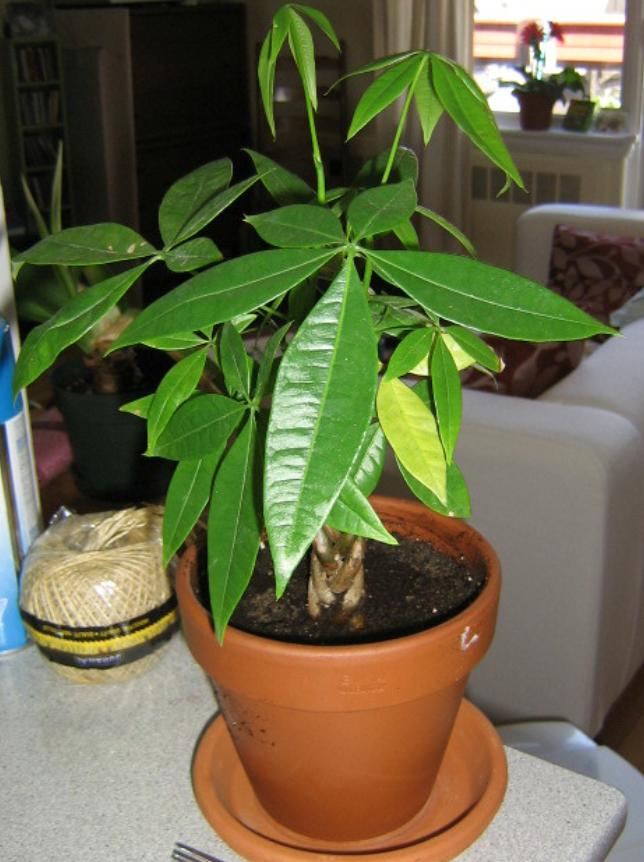Money Tree Plant Care

The money tree plant is an evergreen tree with compound leaves with swollen trunk bases. When a money tree grows in its natural habitat, it can grow up to 20 meters. The plant originated in Central and South America, belongs to the family Malvaceae, and produces fragrant flowers. Here's everything you should know about growing a money tree plant.
Fast Facts for the Money Tree Plants
| Common Name | Malabar chestnut, Guiana chestnut, water chestnut, money plant |
|---|---|
| Scientific Name | Pachira aquatica |
| Harvest | N/A |
| Light | Require bright indirect light, so you should put it close to a sunny window |
| Water | Require 6 to 8 ounces of water once every three weeks; water when the top few inches of the soil get dry |
| Soil | Prefer peat-moss-based soil with a good drainage |
| Fertilizer | A 6-6-6 fertilizer application in the spring and summer months is ideal for the plant |
| Pests | Fungus gnats, whiteflies, mealybugs, and spider mites |
| Diseases | Prone to Bacterial Wilt disease and Rhizoctonia root rot |
| Growing Zone | 10 to 12 |
Table of Contents
Everything You Need to Know to Take Care of A Money Tree
Since money trees are believed to bring good fortune and wealth, many people grow them in their homes. Here's what you should know about taking care of money trees.
Planting
You don't have to wait for a specific month to plant a money tree. Instead, you can plant it at any time of the year. The growing season ranges from spring to early fall. Follow the steps below to plant a money tree:
- Take a small pot measuring 8 to 12 inches in width and fill it with a well-draining potting mix.
- Put your money plant in the soil and pat the surface in place.
- Water the top surface of the soil.
Don't plant the money tree in a container too big for its size. You might think that a larger pot gives the plant more space to grow. However, a young plant does not have a deep root system to absorb the water, resulting in excess water pooling at the bottom of the root ball, causing root rot.

Credit: Isabel Brink
Care and Maintenance
Money tree plant care is relatively easier than other house plants. If you meet the plant's watering, sun, and temperature requirements, it will thrive in no time.
Sun and Temperature
Money tree light requirements are not very extensive. The plant needs indirect sunlight for at least six hours per day. If you keep it indoors, place it in front of a window but not right next to it. Outdoor money plants should be placed in a shady spot. The ideal temperature for money trees is between 65-80°F (16-26°C). Remember no direct sunlight is required.
Water and Humidity
Money plants do not need a lot of water. Only give about three tablespoons of water to your money plant every week. Or you can give it about six ounces of water every three weeks.
Money trees grow well in areas with high humidity of up to 50%. If you live in a low-humidity area, you can increase the air moisture by misting the plant.
Soil
Money tree plants require well-drained soil with sufficient aeration. Since these amendments improve drainage, you can buy a Money Tree soil mix with perlite or coir. The pH of the soil should be between 6.0 and 7.0.
Fertilizing
Fertilizing is an important part of money tree care. You do not have to fertilize the plant in winter, as it only needs extra nutrition in summer and spring. A 6-6-6 fertilizer is ideal for money tree plants.
Pruning
You can prune a money tree throughout the year to remove dead and diseased branches. But if you need to do any major pruning, do it in summer and spring.
Here's how to prune:
- Find two money tree branches that create a V shape on the trunk.
- Put your finger above this shape and create a mark 1⁄2 inch above it.
- Cut the trunk here with sharp gardening shears.
Also, remove branches from the side and top of the tree. If you see any brown, dead, or dry leaves, remove them too.
Propagation
There are two ways to propagate a new money tree from the plant parents; stem cuttings and leaf cuttings. You can propagate the plant in water or soil.
Water Propagation
The simplest way to propagate a money tree is with water. Here's how you can propagate in water with a stem cutting:
- Cut a healthy branch below a leaf node.
- Remove the bottom leaves from the cutting to expose three nodes.
- Keep this cutting aside for three days to let callus form on the cut ends.
- Put the cutting in a jar or glass of water in indirect sunlight.
You can follow this method for leaf cuttings:
- Choose medium-sized healthy leaves and cut them at the point where they connect to the stem.
- Let the leaves form callous for three days.
- Put the leaf cutting in a glass of water in indirect sunlight.
In a few days, you'll see roots forming on the cuttings. It usually takes 30 days to see roots. When they are about two inches long, plant the cutting in a pot filled with well-draining soil.
Soil Propagation
Soil propagation of money trees can be done as follows:
- Fill a pot with a potting mix of your choice.
- Add amendments like peat moss and perlite for enhanced drainage.
- Poke a hole in the soil with your finger and place the leaf or stem cutting into it. Make sure about three nodes of the stem cutting are inside the soil.
- Put a plastic bag over the pot for moisture retention.
- Keep the pot away from too much sunlight.
Roots will start growing in a few weeks, usually three to five. Once the roots grow, repot the cutting into a bigger container.
Did You Know? According to Feng Shui experts, money trees bring ''positive chi'' into your home. They say that it could help lower stress and anxiety.
Common Issues With Money Trees
Like most trees, Money trees don't require a lot of attention, but there's a lot that can go wrong in caring for them. The root cause for most problems stunting a money tree's growth is overwatering. However, there can be some other reasons too. Keep an eye out for these common issues.
Leggy Growth
If your money plant is too ''leggy'', it's not getting enough light. A plant is considered leggy when its trunk or stems become too long and skinny.
Plants tend to grow towards the sun. When they do not get enough sun, they try to grow their stems longer to get more light. A downside of stem growth is that the plant does not spend enough energy on making leaves.
The solution to this issue is to move the plant to a location with more sunlight or invest in artificial lighting.
Drooping Leaves
Money plants have glossy leaves that are quite long and green. If they are droopy, you're likely overwatering your plant. Overwatering damages the plant's root, causing root rot. Avoid this problem by only watering your plants when the soil is dry, about two inches down from the top.
Pests
Money plants are susceptible to the following pests.
Fungus Gnats
Fungus gnats are flies infesting potting mix or soil of money plants. Although they do not cause more than aesthetic damage when present in small numbers, a large infestation can result in stunted plant growth.
You can manage fungus gnats using naturally-occurring biological control agents, such as beneficial nematodes, or by using a commercial insecticide.
Spider Mites
Spider mites are tiny pests that feed on the leaves of money plants. Common symptoms of spider mite infestations include:
- Whitish specks on leaves
- Small yellowish spots
- Silvery-transparent appearance of the leaves
Since water-stressed plants cannot tolerate spider mites well, you should maintain a proper watering schedule. You can also use insecticidal soap or neem oil to get rid of spider mites.
Diseases
Bacterial Wilt disease affects money trees by attacking the young leaves first. It can cause the plant to wilt gradually. Currently, there's no sure-shot cure for this disease, but you can use bactericides to reduce the risk.
Rhizoctonia root rot is another disease of the money plant that mainly damages seedlings but can also affect older plants. While you cannot eliminate the disease altogether, you can suppress it to reduce its damage. Remove branches that are infected and ensure proper drainage in the pot.
Sweet New Earth's Final Word On Money Trees
Money tree plants are among the most beautiful front yard trees in your landscape or indoor trees in your house. By following this simple tree care plan, you can grow a beautiful Money tree for your yard or home.
FAQs
Before you go...
Now that you know how to take care of your Money Tree, you know you need to buy the proper soil so the plant can survive and even thrive within your home. Be sure to read our next article on the best soil for money trees so you can have your favorite plant for years to come...
Related Articles:

Christina Hernandez
Christina has done most of her research on environmental science but recently has changed her focus towards sustainable forestry. She has a passion for the outdoors and wants to spread that passion to the world.
Join our community!
Join to receive guides, insights, and the latest gardening deals!
